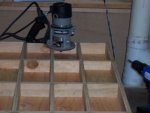Shaz - a torsion box is a box made a certain way so that it's very stiff compared to it's weight. It's a bit hard to explain how to make one in words but let me try.
The underlying principle of a torsion box is the I beam. An I beam has a top and bottom, called the flanges, and a center called the web. It is strong because the flanges resist tension and compression, and the web keeps them from moving relative to each other (and keeps them the same distance apart). If you had an I beam supported on both ends, and put a load in the middle, the top flange would be under compression while the bottom flange would be under tension. The further apart the two flanges (the deeper the web) the stronger the beam.
"Hi Mike  , This is very clear and interesting!..S "
, This is very clear and interesting!..S "
Now, suppose you put a bunch of I-beams side by side and welded the flanges together. You'd have a flat surface that was very rigid along one axis.
"Very clear"
Now, suppose you had some magic machine that would go between the I beams and every foot or so it would weld a web from one I beam to the adjacent one. In essence, it would be creating I beams along the other axis of the surface. Now, that stucture will be very stiff along both axis.
"I can understand this."
To do this in wood, you would cut some webs, maybe 4" wide out of maybe 1/4" plywood. You then arrange those webs in a square pattern interlaced (it'll look like a bunch of pigeon holes when you're finished.
"Each piece gets a half notch to accept the perpendicular pieces, correct?"
Now make an upper and lower surface from maybe 1/2" plywood. When you glue this together, it's very important that the webs are well glued to the top and bottom, and the pigeon hole structure is glued together.
What you're doing is creating a bunch of I beams along both axis.
"That is a sweet deal! "
"
Questions:
1. How high should the web be? Answer: Depends on how strong you need the torsion box to be (and how big the box is). For many applications 4" webs will be fine.
2. How thick do the webs have to be? Answer: Many people make them too thick and that adds weight to the box. 1/4" is plenty strong for most boxes. "I guess some folks go thicker and cut the perpendicular pieces to serve as spacers that can be nailed rather than half notched.
"What do you think the comparison would be between 1/4" webs, half notched verses a 3/4" web with long pieces one way and spacers cut in between, nailed and glued?  Shaz
Shaz  "
"
3. How far apart do the webs have to be? Answer: That's complex. Closer is stronger, but beyond that, it depends on the wood used for the flanges. If the webs are too far apart, you'll get depression of the top between the webs.
4. How thick does the top and bottom have to be. Answer: See Q3, and thicker is stronger. But for many applications 1/2" plywood is sufficient. When in doubt, go with a thicker top.
I hope I didn't forget too much and that this comes close to answering your question.
"Well done, Thank you very much! Shaz "
"
The advantage of a torsion box is great strength and great rigidity with relatively light weight.
Mike
 ,
,

 ,
,

 Shaz"
Shaz" .
. "
" Shaz
Shaz  "
"